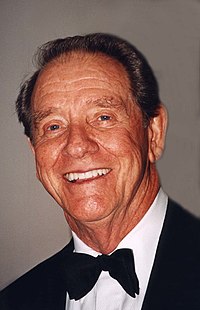
I was reminded the other day of the Disney TV series Zorro (1957-1959, 1960-1961) starring Guy Williams. What a handsome fellow! Zorro means “fox” in Spanish (volpe in Italian). He played a fictional character, a Hispanic version of Robin Hood in 1820s Spanish California; a perfect media role-model for any Hispanic kids tuning in.
Guy Williams was actually born Armand Joseph Catalano, Sicilian on both sides. Early in his film career he took the odd stage name Guido Armando. But when his first agent alerted him to the drawbacks of such a moniker he changed it Guy Williams. The new name and his sensational Latin looks won him the Zorro role. The Disney folks told him to grow his dashing signature mustache for the part. He was taught to fence by the same instructor who taught Errol Flynn and Douglas Fairbanks.
In 1964, having done a few cameo roles in the TV series Bonanza he was slated to replace actor Pernell Roberts as one of the four sons. However, Roberts stayed on leaving Guy to seek work elsewhere. Elsewhere was the hit series Lost in Space (1965-1968) where he played Professor John Robinson, neither Latin nor Italic.

The late 1950s and early 60s were a transition period for our Italian American media image. Italic role models like Guy Williams and Anne Bancroft (born Anna Maria Luisa Italiano) lay hidden in plain sight. Even Henry Fonda and Richard Crenna had Italian surnames but never clicked as paesani. According to Wikipedia, the Fondas originated in Genoa and “migrated to the Netherlands in the 15th century. In 1642, a branch of the Fonda family immigrated to the Dutch colony of [New Amsterdam, now New York]. They were among the first Dutch population to settle in what is now upstate New York, establishing the town of Fonda, NY. By 1888, many of their descendants had relocated to Nebraska.”
I have a handwritten letter from the late author/pundit Gore Vidal, who also claimed Italian roots as a “Vitale,” recounting how he and Fonda were disappointed that Italian Americans never identified with them. But, doesn’t it go both ways?
Truth be told, we were on a downhill slide from 1959 with the TV premier of The Untouchables (aka “cops & wops”) and the blockbuster comedy movie Some Like It Hot with its Capone references. By 1964, it was live TV coverage of the Valachi (“Cosa Nostra”) Hearings in Congress. The fictional bestseller The Godfather in 1968 sealed our doomed image.

Actors with Italian roots rarely had the opportunity to save our image. Their on-screen personae were non-Italic —Alan Alda (born D’Abruzzo) was Hawkeye Pierce in M.A.S.H, although his father Robert did two cameo appearances as Army Dr. Anthony Borelli. Bernadette Peters (born Lazzara) never publicized her italianità; and certainly not Susan Sarandon (mother: Criscione). In fact when we honored her successful career at a Waldorf=Astoria gala in 1999, she didn’t attend or even acknowledge the award.
Immensely talented Anne Bancroft was an Italian Bronx gal who saw her heritage humorously. Her only tribute to her roots was a 1980 comedy she wrote, directed, and starred in titled Fatso, with comedian Dom DeLuise as a serial glutton living in her old Bronx neighborhood. It grossed only $7 million, not really worth the laughs. Ironically she met the love of her life, Jewish Mel Brooks, on Perry Como’s Kraft Music Hall.
Which brings me to the real heroes of our culture back then: the vocalists. The likes of Perry Como, Frank Sinatra, Dean Martin, Connie Francis, and Mario Lanza never disappointed us. Those hidden in plain sight without the vowels like Tony Bennett, Frankie Laine, Bobby Darin were still identifiable by the community, as were most of the Rock n Roll artists and groups from the 1960s.
For many of us, those hidden idols shaped our pride. -JLM




and these are just the big names… there were countless Italian American artists, performers, and entertainers, along with other fields…that was very confused or conflicted by their Italian roots….I recall a friend saying the reason his grandparents Americanized their name was to “get ahead” and usually for economic mobility reasons. But along with the name change came a strange assimilation since they really could not bring or share much to a discussion of family heritage, because they would have to disclose or discuss their family roots…… thankfully that does not happen much these days….but the good old days were not necessarily good for everyone…and reconstructing roots once they are lost is an arduous process.
It was brought to my attention that more Americans are identifying as ethnic Italian on the Census. Strange but maybe it’s a cool thing for some mixed ethnics.
Also: In the 1960s, Frankie Avalon and Annette Funicello were the clean-cut, “All American” alternatives to the hippies in Easy Rider and the biker gangs in Hell’s Angels. And today?
Our youth is represented by the Neanderthals on Jersey Shore or by tattooed YouTube influencers who don’t even know that Guglielmo Marconi invented wireless transmission—the very thing which has led to cable TV and YouTube.